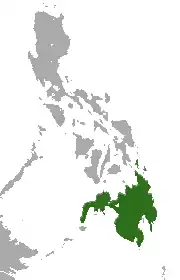| Mindanao treeshrew[1] | |
|---|---|
| Scientific classification | |
| Domain: | Eukaryota |
| Kingdom: | Animalia |
| Phylum: | Chordata |
| Class: | Mammalia |
| Order: | Scandentia |
| Family: | Tupaiidae |
| Genus: | Tupaia |
| Species: | T. everetti |
| Binomial name | |
| Tupaia everetti | |
 | |
| Mindanao treeshrew range | |
The Mindanao treeshrew (Tupaia everetti), also called the Philippine tree shrew, is a species of treeshrew endemic to the Mindanao region in the Philippines.[2] It was formerly considered the only member of the genus Urogale,[1] but that genus was merged into Tupaia when the species was found to nest within the latter genus in a molecular phylogeny.[5] The scientific name commemorates British colonial administrator and zoological collector Alfred Hart Everett.
Range and habitat
It is found, as its name suggests, in Mindanao, in the Philippines. It lives in rain forest and montane forest.
Description
It is the heaviest treeshrew, weighing about 355 g, and is terrestrial.[6] The body is 17–20 cm, and the tail is 11–17 cm. It has a particularly elongated snout and a rounded, even-haired tail. The fur is brownish, but with orange or yellow underparts.
It is diurnal in its habits, and it climbs well and runs fast on the ground.
Diet
Its diet is varied. It includes insects, lizards, young birds, bird's eggs, and fruit.
Reproduction
In the wild, it is thought to nest on the ground or on cliffs. Their breeding habits have been observed in captivity, where females have produced one or two young after a gestation period of 54–56 days.
References
- 1 2 Helgen, K.M. (2005). "Order Scandentia". In Wilson, D.E.; Reeder, D.M (eds.). Mammal Species of the World: A Taxonomic and Geographic Reference (3rd ed.). Johns Hopkins University Press. pp. 108–109. ISBN 978-0-8018-8221-0. OCLC 62265494.
- 1 2 Kennerley, R. (2019). "Tupaia everetti". IUCN Red List of Threatened Species. 2019: e.T22784A130877829. doi:10.2305/IUCN.UK.2019-1.RLTS.T22784A130877829.en. Retrieved 20 November 2021.
- ↑ "Appendices | CITES". cites.org. Retrieved 2022-01-14.
- ↑ Thomas, Oldfield (1892). "On some new mammalia from the East-Indian Archipelago". Annals and Magazine of Natural History. 6 (9): 250–254. doi:10.1080/00222939208677313. ISSN 0374-5481.
- ↑ Roberts, T.E.; Lanier, H.C.; Sargis, E.J.; Olson, L.E. (2011). "Molecular phylogeny of treeshrews (Mammalia: Scandentia) and the timescale of diversification in Southeast Asia". Molecular Phylogenetics and Evolution. 60 (3): 358–372. doi:10.1016/j.ympev.2011.04.021. PMID 21565274.
- ↑ Napier JR, Napier PH. (1968) A handbook of living primates. Morphology, ecology and behaviour of nonhuman primates. Academic, London
- Macmillan Illustrated Animal Encyclopedia
